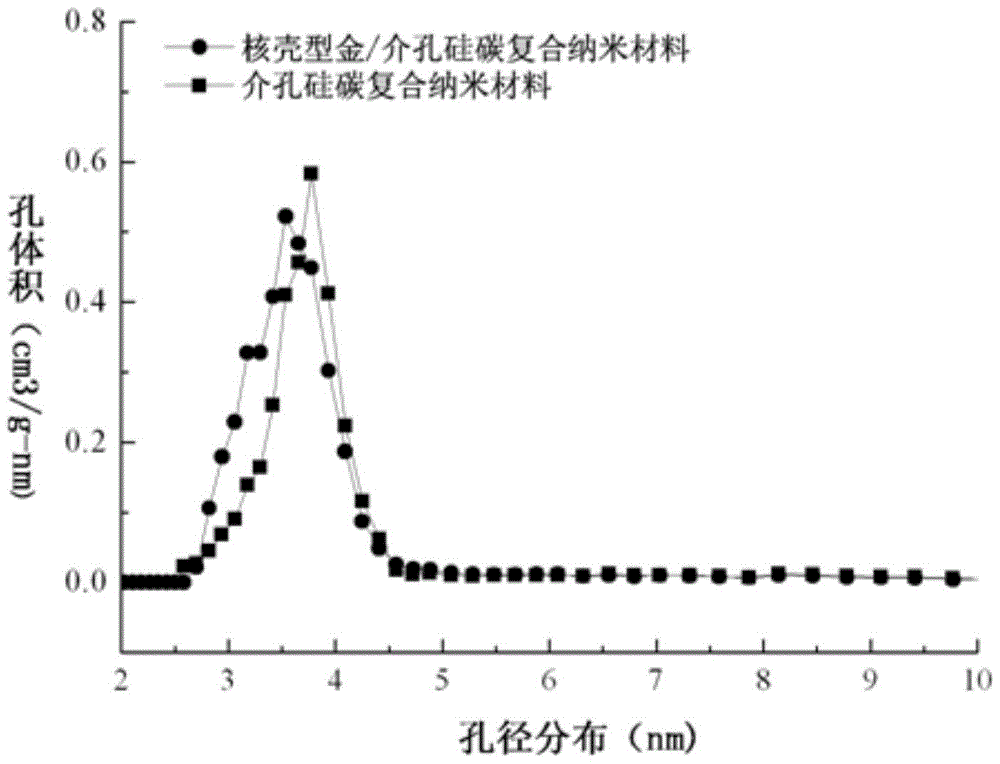A core-shell gold/mesoporous silicon-carbon composite nanomaterial, preparation method and application
A technology of composite nanomaterials and nanomaterials, which is applied in the fields of advanced nanocomposite materials and biological and medical analysis and detection, can solve problems such as background interference of low molecular weight analytes, and achieve avoidance of interference from matrix molecular ion peak signals and high mechanical strength and chemical stability to achieve accurate analysis
- Summary
- Abstract
- Description
- Claims
- Application Information
AI Technical Summary
Problems solved by technology
Method used
Image
Examples
Embodiment 1
[0041] Example 1, Preparation of core-shell gold / mesoporous silicon-carbon composite nanomaterials
[0042] (1) Mix ethanol and water at a ratio of 1:1, add 0.640g of cetyltrimethylammonium bromide, heat up to 70°C and stir well; add 55mg of chloroauric acid, stir for 5-10min, then add Adjust the pH to 10-12 with KOH, maintain the reaction at 70°C for 30 minutes, add deionized water twice the volume of the initially added water, add tetraethyl orthosilicate dropwise and add KOH again to maintain the pH between 10-12, and react at 70°C for 2 hours , centrifuged, washed, and dried to prepare a nanomaterial with gold nanoparticles as the core and an ordered mesoporous structure of silica-surfactant as the shell;
[0043] (2) Disperse the above composite material in a dilute sulfuric acid solution, raise the temperature to 100°C and 160°C in turn, and maintain it for 12h, and then calcinate at 600°C for 3h under an argon atmosphere to realize the synthesis of the surfactant cetylt...
Embodiment 2
[0044] Example 2, Preparation of Core-shell Gold / Mesoporous Silicon Carbon Composite Nanomaterials
[0045] (1) Mix methanol and water at a ratio of 1:3, add 0.640g of cetyltrimethylammonium bromide, heat up to 60°C and stir well; add 55mg of chloroauric acid, stir for 5-10min, then add Adjust the pH to 10-12 with NaOH, maintain the reaction at 60°C for 30 minutes, add 1.5 times the volume of deionized water initially added, add methyl orthosilicate dropwise and add NaOH again to maintain the pH between 10-12, and react at 60°C for 2 hours , centrifuged, washed, and dried to prepare a nanomaterial with gold nanoparticles as the core and an ordered mesoporous structure of silica-surfactant as the shell;
[0046] (2) Disperse the above composite material in dilute sulfuric acid solution, raise the temperature to 100°C and 160°C in sequence, and maintain it for 12h, then calcinate at 550°C for 3h under a nitrogen atmosphere to achieve the synthesis of the surfactant cetyltrimethy...
Embodiment 7
[0050] Embodiment 7, the method for detecting amino acid sample arginine
[0051] (1) The instrument is: AB SCIEX TOF / TOF TM 5800System mass spectrometer; nitrogen laser, wavelength 337nm, adopts ion delayed extraction (delayed extraction) and reflection (reflectorn) working mode, positive ion detection.
[0052] (2) The mixed spotting method was used, that is, the amino acid sample solution and the core-shell gold / mesoporous silicon carbon composite nanomaterial solution were pre-mixed, fixed on a MALDI plate, dried naturally, and analyzed by laser desorption ionization mass spectrometry.
PUM
 Login to View More
Login to View More Abstract
Description
Claims
Application Information
 Login to View More
Login to View More - R&D
- Intellectual Property
- Life Sciences
- Materials
- Tech Scout
- Unparalleled Data Quality
- Higher Quality Content
- 60% Fewer Hallucinations
Browse by: Latest US Patents, China's latest patents, Technical Efficacy Thesaurus, Application Domain, Technology Topic, Popular Technical Reports.
© 2025 PatSnap. All rights reserved.Legal|Privacy policy|Modern Slavery Act Transparency Statement|Sitemap|About US| Contact US: help@patsnap.com



